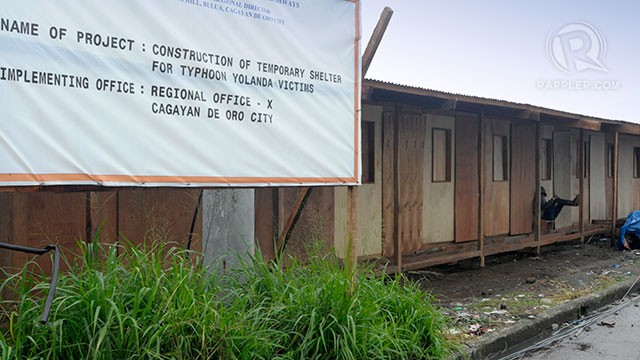SUMMARY
This is AI generated summarization, which may have errors. For context, always refer to the full article.

MANILA, Philippines – Slammed for building cramped bunkhouses, the Department of Public Works and Highways (DPWH) admitted it was initially clueless about a key international benchmark for sheltering typhoon survivors.
Public Works Secretary Rogelio Singson told Rappler it was his first time on Tuesday, January 7, to read the standards in the Sphere Handbook, a widely recognized benchmark for humanitarian response.
Humanitarian groups had cited Sphere in criticizing the bunkhouses that the DPWH commissioned for Super Typhoon Yolanda (Haiyan) survivors.
Asked if the DPWH was aware of Sphere before this, Singson said in a phone interview: “I finally got hold of what we were talking about today… ‘yung Sphere standards na sinasabi nila, ngayon (…the Sphere standards that they were talking about, today).”
He explained that the DPWH, first of all, had not been part of the talks of the Shelter Cluster, a grouping of United Nations (UN) agencies that coordinate humanitarian shelter.
He relayed this concern to Social Welfare Secretary Dinky Soliman last week.
“Sabi ko, ‘Dinky, ‘pag nag-meeting naman kayo, you let us know so that we can attend, so that we can address all the concerns of the Shelter Cluster. Kasi kami hindi miyembro ng Shelter Cluster,” he said. (I told her, “Dinky, if ever you meet, you let us know so that we can attend, so that we can address all the concerns of the Shelter Cluster. Because we’re not part of the Shelter Cluster.”)
“We were never invited in any of the cluster meetings,” he said.
The lack of information showed in the bunkhouse units.
2 ping-pong tables
The units failed to meet Sphere standards at first. Before the DPWH improved these, the temporary shelters fell short of Sphere standards by around 50%.
Sphere says a shelter for disaster survivors should provide 3.5 square meters per person.
In Yolanda-hit Eastern Visayas, where the average household size is 4.7, a bunkhouse unit for an average family should therefore measure at least 16.45 square meters.
“The original design of DPWH,” however, was for a bunkhouse unit to measure 8.64 square meters, Singson said in a media briefing Monday, January 6.
That’s roughly the area for two ping-pong tables.
Consulting with the Department of Social Welfare and Development (DSWD), the DPWH initially allotted this space for Yolanda-hit families to eat, sleep, and wait for two years until the government finishes permanent shelters for them.
This triggered concerns for Yolanda survivors as they marked on Wednesday, January 8, the second month since the super typhoon damaged a million homes and killed more than 6,180 people.

‘They didn’t tell us’
“All the DPWH-commissioned bunkhouses being developed in Tacloban (and we understand in all locations) are non-compliant in many respects with internationally recognized standards and best practice as set down in Sphere standards,” said a document found on the website of Camp Coordination and Camp Management (CCCM), an international group involved in rehabilitation.
The group found this puzzling, according to the report dated Dec 21, 2013. After all, “a few weeks ago,” the DSWD presented to them designs and layouts that “are broadly speaking compliant with Sphere standards.”
“It is unclear why such significant differences exist,” the document on the CCCM website said.
The initial bunkhouses posed threats to privacy and “of further geohazards,” such as flooding and landslides, it added.
On Tuesday, Singson said groups should’ve told the DPWH about this much earlier.
“‘Yun ngang sinasabi nila ay mas malalaki ang gusto nilang itayo. Eh sabi ko, kung nasabi n’yo ‘yan nang maaga sa amin, eh ‘di sana ganoon ang ginawa namin,” Singson said. (What they’re saying is that they wanted us to build wider ones. I said, if you told us about this earlier, then we would’ve done that.)
UN: Dialogue, improvements
In any case, Singson said, the DPWH improved the bunkhouses based on the groups’ comments.
On Monday, he told reporters the DPWH lessened the number of units per bunkhouse to create more space. From 24, the DPWH reduced the units to 12 per bunkhouse.
That’s equivalent to 17.28 square meters per unit, exceeding the 16.45 square meters recommended by Sphere for average Eastern Visayas families.
The United Nations Office for the Coordination of Humanitarian Affairs (UNOCHA) acknowledged this move.
“With facilitation by the Camp Coordination and Camp Management Cluster, humanitarians’ role has been to engage in a constructive dialogue with the government to ensure that bunkhouses follow good practice regarding adequate living space, privacy, safety, and access to water and sanitation,” said UNOCHA public information officer Gemma Cortes in an e-mail to Rappler.
“This dialogue has led to improvements,” Cortes said. “For instance, the government has already increased the living space per family. This, in turn, will increase ventilation, reduce incidence of communicable disease, and reduce the number of families sharing a latrine.”
Rehabilitation Secretary Panfilo “Ping” Lacson, for his part, said giant firms will come to the rescue.
On Tuesday, he said these corporations pledged to “adopt” areas hardest hit by Yolanda. (READ: Giant firms ‘adopt’ Haiyan-hit areas.)
To rebuild the lives of more than 16 million affected residents, the government will need around P360.9 billion in a span of 4 years. (READ: PH needs P361B for post-Yolanda rehab.) – Rappler.com
Add a comment
How does this make you feel?
There are no comments yet. Add your comment to start the conversation.